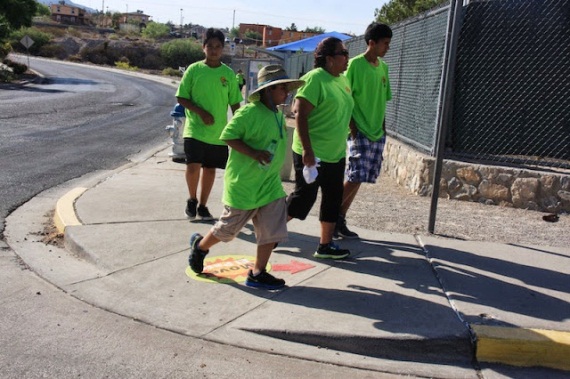Share On Social!
How do you get an entire city of people to get up and moving?
Build them new trails and places to walk!
That’s what happened when Angela Mora and other El Paso city officials teamed with community groups to gather a small budget and launch Move! El Paso Fitness Trails. The initiative created 13 new walking trails for the community, expanding the opportunities for people to walk, get moving, and reduce obesity!
The Struggle to Stay Active in El Paso
Angela Mora, deputy director of the El Paso Public Health Department, was well aware of the city’s growing obesity problem.
A lack of physical activity opportunities was a big reason for these obesity rates. A few years ago, about 29% of adults in El Paso County were physically inactive, compared to state and national averages of 13% and 20%.

Mora wanted to do something about it.
Mora was also concerned about the wellbeing of the city’s 6,000+ employees. Although employees already had the opportunity to participate in a wellness program, she felt that more could be done to encourage them to get out and walk more.
In 2009, partners from throughout the city, including Mora, decided it was time to take action and find ways to reshape the environment for healthy living.
That year, the Paso Del Norte Foundation (PDNF) invited leaders from throughout the community to participate in a Health Eating Active Living Coalition. Partners from what was formerly the Pan American Health Organization’s United States-Mexico Border Office (PAHO-USMBO) had received a healthy living, childhood obesity prevention grant from the Robert Wood Johnson Foundation (RWJF) Healthy Kids, Healthy Communities (HKHC) program.
Shortly after this that Mora came up with the idea for a Move El Paso initiative.
Although funds at the health department were limited, in 2012 Mora learned the health department had about $5,000 in seed money to implement a new project.
An Idea: New Trails to Boost Walkability
Mora’s idea was simple: create a small number of trails that linked to health-related facilities and to other public venues.
Mora knew her idea would need the backing of some of her colleagues, so she decided to reach out to the city’s transportation department, PDNF, and PAHO-USMBO.
She thought it would be an easy sell.
 “In El Paso we’re like a family,” Mora said. “I said how do you like this idea and really everybody I reached out to was interested in working with us.”
“In El Paso we’re like a family,” Mora said. “I said how do you like this idea and really everybody I reached out to was interested in working with us.”
Mora first pitched her idea for creating Move! El Paso trails to Ted Marquez, head of the city’s transportation department (DOT).
“We are sister departments and support each other as much as possible,” Mora said. “He believed in what we were doing and he was able to provide staff support.”
Mora then picked up the phone and contacted Maria Cerqueira, who was head of PAHO-USMBO at the time, and Michael Kelly of the Paso Del Norte Foundation. Both parties agreed to join Mora in her quest to get more people throughout the city walking.
They formed a small Move! El Paso committee and met as needed, sometimes monthly, sometimes weekly.
Each committee representative played a different role. According to Mora, the DOT’s role was instrumental because they already knew of vendors that could create and install trail markings and signage needed for the trails. The DOT also helped Mora with conducting environmental scans of the terrain to ensure that the trails were in good condition.
“We made sure that there were no potholes, that sidewalks were leveled and that there were no hazards,” Mora said.
Seeking Funding and Promotion of the Trails
Recognizing the great potential of this initiative, the Paso Del Norte Foundation supported Move! El Paso with an additional $4,900 in funding. The Texas State Health Department also provided funding.
Part of the funding allowed Mora to work with a graphic designer to create the Move! El Paso logo. Then she worked with the committee to create maps for six potential trails that could help kick off the Move El Paso initiative.
“The idea was to connect these trails to facilities that promoted health and health literacy,” Mora said.
Places like libraries, parks, and WIC centers were marked along the map of each trail.
Partners from PAHO, along with its student-driven Ecoclub, also contributed to trail efforts by conducting a walkability assessment of trails in one of El Paso’s most impoverished neighborhoods, El Chamizal. Then other organizations such as the Mexican Consulate, a group from the district’s medical center, and a local health clinic also decided to join in on efforts to promote walking.
“Texas Tech came in and they wanted to partner with us,” Mora said. “So they created trails that linked to Move El Paso trails—they did an extension.”
At this point Mora brought on volunteers from the University of Texas El Paso (UTEP) to help out with the trails’ promotional efforts.
To rally support for change, Mora’s team developed flyers, public service announcements, and bilingual brochures with information about the new trails to be opened to the community.
Each brochure contained:
- a map of the trail;
- safety tips;
- a summary of the health benefits of walking; and
- an activity log, to help trail users record the day and amount of time spent on the trail.
 Each trail head would have a pole with a poster-sized map that shows the route of the trail and where to find nearby parks, schools, libraries and health clinics. Distance markers at ¼, ½, ¾, and 1 mile intervals would show people how far they’ve walk.
Each trail head would have a pole with a poster-sized map that shows the route of the trail and where to find nearby parks, schools, libraries and health clinics. Distance markers at ¼, ½, ¾, and 1 mile intervals would show people how far they’ve walk.
All in all, costs associated with the development of each trail were relatively low, about $3,000 per trail.
Trail Markers Approved
Along with support from a third party vendor, shortly before the summer of 2012, the team from the city’s DOT began installing the new Move! El Paso trail markers and trailhead poles.
The first wave of six Move! El Paso trails (launched in June 2012) were located in downtown El Paso (3 trails), the Segundo Barrio neighborhood, near the Mexican Consulate, and by the local medical center.
“The trails really give a lot of direction to community members and incentive to walk,” Mora said. “It is helpful to know that the place is safe, that we have given some attention to giving the community something viable for them to use anytime they feel like it.”
Getting People on the Trails
To get city employees and the community motivated to use the trails, the city’s public health department hosted five Saturday walking events starting in June 2012. During each of these events, city employees and volunteers led several 40-minute-long walking tours, which took participants on 0.5-1.5 mile walks throughout downtown El Paso.
For the rest of the summer, walking events continued at each of the new trail sites.
 As word spread around about the Move! El Paso initiative, more groups started to reach out to Mora to see what could be done to launch a Move! El Paso trail at their site.
As word spread around about the Move! El Paso initiative, more groups started to reach out to Mora to see what could be done to launch a Move! El Paso trail at their site.
In 2013, a new Move El Paso! trail at El Chamizal was opened to the public followed by 6 more trails. Holly Mata, coordinator of Shift+ (Shift Positive), an initiative of the Paso del Norte Health Foundation that aims to reduce underage and binge drinking, joined Mora and others from the community for the launch of the El Chamizal trail.
“What I think is really cool about the trails is that it makes it easy to get the recommended levels of physical activity,” Mata said.
By May 2013, Move! El Paso had over 13 new walking trails.
In order to further promote the trails, the Move! El Paso committee developed two promotional videos (in English and Spanish).
Mora said the trail signs are expected to remain in good condition for at least 10 years. In the meantime, the DOT will work to maintain them. Efforts to promote trail use throughout the community will continue.
Mata, who has worked to bring smoke-free policies to the city’s housing authority, has also heard from a group of motivated teens living within the city’s housing authority and belonging to the Alpha Youth Leadership Academy, that they would like to work to expand the trails.
Mata said she frequently sees city employees walking the trails.
“What I’ve noticed is it’s become really common to see people put on their sneakers and walk at lunch time,” she said. “Another great thing about these trails is that by walking these trails you get to see parts of neighborhoods that you might not ordinarily get to see.”
Explore More:
Green & Active SpacesBy The Numbers
33
percent
of Latinos live within walking distance (<1 mile) of a park
This success story was produced by Salud America! with support from the Robert Wood Johnson Foundation.
The stories are intended for educational and informative purposes. References to specific policymakers, individuals, schools, policies, or companies have been included solely to advance these purposes and do not constitute an endorsement, sponsorship, or recommendation. Stories are based on and told by real community members and are the opinions and views of the individuals whose stories are told. Organization and activities described were not supported by Salud America! or the Robert Wood Johnson Foundation and do not necessarily represent the views of Salud America! or the Robert Wood Johnson Foundation.



